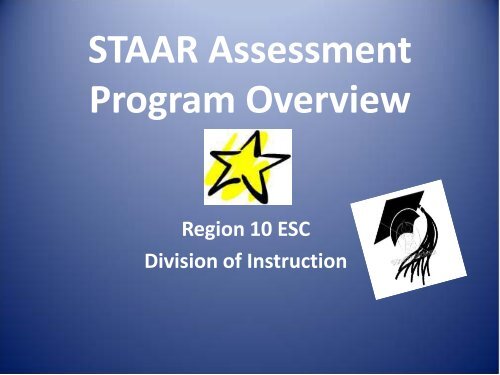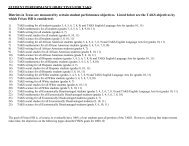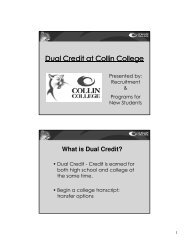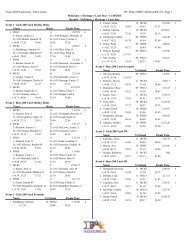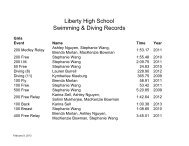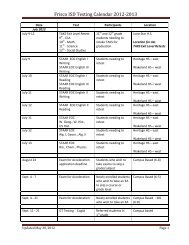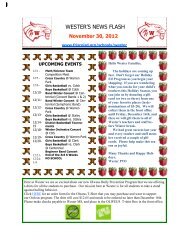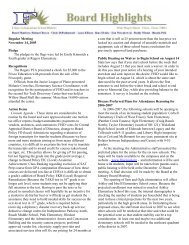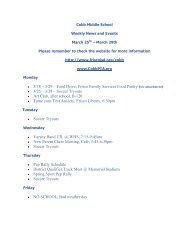STAAR Assessment Program Overview - Frisco ISD
STAAR Assessment Program Overview - Frisco ISD
STAAR Assessment Program Overview - Frisco ISD
Create successful ePaper yourself
Turn your PDF publications into a flip-book with our unique Google optimized e-Paper software.
<strong>STAAR</strong> <strong>Assessment</strong><br />
<strong>Program</strong> <strong>Overview</strong><br />
Region 10 ESC<br />
Division of Instruction
The difficulty lies not so much in<br />
developing new ideas as in<br />
escaping from the old ones.<br />
- John Maynard Kynes
<strong>STAAR</strong> Information<br />
State of Texas <strong>Assessment</strong>s of Academic Readiness<br />
(<strong>STAAR</strong>) Resources<br />
Stay informed!<br />
www.tea.state.tx.us/student.assessment/staar<br />
Join TEA Listservs!<br />
http://miller.tea.state.tx.us/list<br />
Your content area, student assessment, other areas of<br />
interest
• Who will be tested?<br />
• What will be tested?<br />
Today…<br />
• How will <strong>STAAR</strong> be different from TAKS?<br />
• What are the graduation implications?<br />
• What is important in each content?
Who will be tested?<br />
• Students enrolled in any of the following<br />
courses (regardless of grade level):<br />
– Algebra I, Geometry, Algebra II<br />
– World Geography, World History, US History<br />
– Biology, Chemistry, Physics<br />
– English I, II, III<br />
• Tested over two days – Reading one day; Writing one<br />
day
• TABS – Basic Skills<br />
<strong>STAAR</strong><br />
• TEAMS – Minimum Skills<br />
• TAAS – Academic Skills<br />
• TAKS – Knowledge and Skills<br />
• <strong>STAAR</strong> – State of Texas <strong>Assessment</strong> of<br />
Academic Readiness
• “Reporting Categories”<br />
– Replace TAKS Objectives<br />
What will be tested?<br />
• “Readiness Standards” – Student expectations that are<br />
tested every year<br />
– Essential for success in the current grade or course<br />
– Important for preparedness for the next grade or course<br />
– Supports college and career readiness<br />
– Necessitates in-depth instruction<br />
– Address broad and deep ideas<br />
• “Supporting Standards” – SEs that are tested on a 3 year<br />
rotating basis
What will be tested?<br />
• Assessed Curriculum Document<br />
– Identifies the readiness and supporting standards<br />
• Blueprint<br />
– Breaks down each reporting category by<br />
readiness, supporting, and number of questions<br />
• Test Design Schematic<br />
– For reading/ELA only, outlines genres, number of<br />
selections, and word count<br />
• Rubrics<br />
– For writing/ELA only
What will be tested?<br />
• Assessed Curriculum Document<br />
– Identifies the readiness and supporting standards<br />
• Blueprint<br />
– Breaks down each reporting category by<br />
readiness, supporting, and number of questions<br />
• Test Design Schematic<br />
– For reading/ELA only, outlines genres, number of<br />
selections, and word count<br />
• Rubrics<br />
– For writing/ELA only
What will be tested?<br />
• Assessed Curriculum Document<br />
– Identifies the readiness and supporting standards<br />
• Blueprint<br />
– Breaks down each reporting category by<br />
readiness, supporting, and number of questions<br />
• Test Design Schematic<br />
– For reading/ELA only, outlines genres, number of<br />
selections, and word count<br />
• Rubrics<br />
– For writing/ELA only
Combining Content and Process<br />
Standards – Social Studies Example<br />
• 8.29D Identify points of view from the historical context<br />
surrounding an event and the frame of reference which<br />
influenced the participants.<br />
• 8.4C Explain the issues surrounding important events of<br />
the American Revolution, including declaring<br />
independence; writing the Articles of Confederation;<br />
fighting the battles of Lexington, Concord, Saratoga, and<br />
Yorktown; enduring the winter at Valley Forge; and<br />
signing of the Treaty of Paris
Together:<br />
• Analyze how the frame of reference of<br />
various significant Americans impacted the<br />
their points of view regarding the signing of<br />
the Declaration of Independence, the work of<br />
militias, joining troops at Valley Forge or the<br />
signing of the Treaty of Paris
Combining Content and Process<br />
Standards – Math Example<br />
• 6.12B Evaluate the effectiveness of different<br />
representations to communicate ideas.<br />
• 6.3B Represent ratios and percents with<br />
concrete models, fractions, and decimals.
Together<br />
• Evaluate the effectiveness of a concrete or<br />
pictorial model representing percent.
What will be tested?<br />
• Examine the resources at your table<br />
• Discuss the following questions and be prepared to<br />
report out<br />
– What surprises you?<br />
– What concerns you?<br />
– What immediate needs for instruction (materials,<br />
scope and sequence revision, etc) come to mind?<br />
– What types of training will be needed?<br />
– How ready are your students?
What will be tested?<br />
• Release of Test Questions<br />
Primary forms of <strong>STAAR</strong> will be released<br />
every three years as required.<br />
• TEA may defer releasing assessments to the<br />
extent necessary to develop additional<br />
assessments.<br />
• Prior to 2012, TEA plans to release a small<br />
set of assessment items.
How will <strong>STAAR</strong> content be different from<br />
• More questions<br />
TAKS?<br />
• Items cognitively more challenging<br />
• Answer choices closer together – “best answer”<br />
• Items coded dually (Process and content)<br />
• Reference materials will be embedded in test booklet<br />
• Linguistically accommodated version available – <strong>STAAR</strong>-L<br />
(paper only until 2013)<br />
• No phase in of <strong>STAAR</strong>-Alt – TAKS Alt will no longer exist<br />
after Spring 2011
Accommodated??<br />
No Accommodated version<br />
– The “regular” <strong>STAAR</strong> will incorporate characteristics of<br />
TAKS Accommodated<br />
• More white space<br />
• Verdana font, bigger font<br />
• Single columns<br />
– No accommodations manual will be provided in the<br />
first year of the <strong>STAAR</strong> assessment program<br />
• Policy letters (TAA letters) will be disseminated as decisions<br />
are made
<strong>STAAR</strong> M<br />
• Fewer questions than <strong>STAAR</strong>, but longer than<br />
TAKS M<br />
• 3 rather than 4 answer choices<br />
• Increased rigor<br />
– 2 compositions in Writing<br />
– Dual coded items in Science and Social Studies<br />
– Griddables (math), open ended responses<br />
(reading), and “make no changes”<br />
(writing/ELA)?? – no decision yet<br />
• Time limit?? - no decision yet<br />
• Blueprints not available yet
<strong>STAAR</strong> M<br />
• <strong>STAAR</strong> M (EOC) availability<br />
– 2012<br />
• English I, English II, Algebra I, Geometry, Biology,<br />
World Geography<br />
– 2013<br />
• World History<br />
– 2014<br />
• US History, English III
Dyslexia Bundle<br />
• Extended to English I, II and III EOCs<br />
• For these tests, two of the original three<br />
accommodations will be allowed<br />
– Oral reading of item stems/answer options<br />
– Extended time
How will <strong>STAAR</strong> logistics be different from<br />
TAKS at the HS?<br />
• Three testing opportunities – fall, spring, summer<br />
• Online or on paper at HS<br />
• Passing/met standard will be set in February of<br />
2012 for EOC<br />
• in 2013 and beyond – 45 days of testing overall<br />
• 4 hour time limit (possibility at HS of 2 tests in one<br />
day)
4 Hour Time Limit
2011-12 Testing Calendar (HS)<br />
• October 18 – 21<br />
– Exit level TAKS re-test<br />
• March 5 and 7-9<br />
– Exit level TAKS re-test<br />
– Grades 10 and 11 TAKS ELA<br />
• March 26 – 29<br />
– <strong>STAAR</strong> English I, II, III<br />
• April 23 – 27<br />
– Exit level TAKS re-test<br />
– Grades 10 and 11 TAKS Math, Science, Social Studies
2011-12 Testing Calendar (HS)<br />
• May 7 – 17<br />
– <strong>STAAR</strong> EOC (all but English I, II, III)<br />
• July 9 – 13<br />
– <strong>STAAR</strong> EOC re-test (all)<br />
– Exit level TAKS re-test
• To graduate<br />
What are the graduation<br />
requirements?<br />
– a student must earn at least the minimum<br />
standard on all EOC assessments taken<br />
– Achieve a cumulative score that is greater than<br />
or equal to the number of EOC assessments<br />
taken multiplied by the satisfactory standard
Unsatisfactory<br />
What are the graduation<br />
requirements?<br />
Satisfactory<br />
Advanced
• Science<br />
End of Course <strong>STAAR</strong> Examples<br />
– Minimum = 900<br />
– Satisfactory = 1000<br />
– Advanced = 1500<br />
• To graduate, a student must<br />
– Score at least 900 on all science EOCs taken<br />
– Achieve a cumulative equal to 1000 times the<br />
number of EOCs taken
• Student 1 scores:<br />
1200 on Biology<br />
800 on Chemistry<br />
1100 on Physics<br />
Student Example 1<br />
• Chemistry score of 800 does not meet the minimum score<br />
requirement of 900 and CANNOT be used towards the<br />
cumulative score.<br />
• Then the student’s cumulative score is 2300 which does<br />
not meet the cumulative score requirement of 3000<br />
• This student must RETEST IN CHEMISTRY
• Student 2 scores:<br />
950 on Biology<br />
1000 on Chemistry<br />
900 on Physics<br />
Student Example 2<br />
• The student met minimum on all 3 EOC assessments<br />
• The student’s cumulative score is 2850 which does not<br />
meet the cumulative score requirement of 3000<br />
• This student must re-test – but which one to re-test?
Diploma Requirements<br />
• Minimum High School <strong>Program</strong><br />
– Student must earn the minimum score on each<br />
EOC assessment<br />
• Recommended High School <strong>Program</strong><br />
– In addition to earning the minimum on each EOC,<br />
students must earn the “satisfactory” score on<br />
Algebra II and English III<br />
• Distinguished Achievement <strong>Program</strong><br />
– In addition to earning the minimum on each EOC,<br />
students must earn the “advanced” score on<br />
Algebra II and English III
The 15% effect<br />
• “ TEA does not have the authority to tell<br />
districts how to calculate grades”<br />
• Class rank, GPA, graduation<br />
• Conversion from scale score to GPA<br />
• Region 10 Information Booklet on the 15% was<br />
provided to all districts
What is important in<br />
each content area?
Reading<br />
• Fiction and Expository on every Test<br />
• Other genre are supporting standards<br />
– Poetry, Drama, etc. not every year, but some years.<br />
Won’t know which<br />
• Procedural text and media literacy included<br />
within the fiction or expository text<br />
• Author’s craft questions:<br />
– Why did the author use the phrase…<br />
– Why did author conclude the second paragraph with<br />
an ellipsis?
Literary Strand<br />
• Fiction<br />
• Literary Nonfiction<br />
• Poetry<br />
• Drama<br />
Genres Assessed<br />
– Assessed beginning at 4 th grade<br />
• Media Literacy<br />
– Embedded<br />
Readiness Genre<br />
Supporting Genre<br />
Supporting Genre<br />
Supporting Genre
Informational Strand<br />
• Expository<br />
• Persuasive<br />
Genres Assessed<br />
– Assessed beginning at 5 th grade<br />
• Procedural<br />
– Embedded<br />
• Media Literacy<br />
– Embedded<br />
Readiness Genre<br />
Supporting Genre
Paired Selections<br />
• Can mix strands and genres<br />
– Literary−Literary<br />
• fiction−poetry<br />
• literary nonfiction−drama<br />
• fiction−literary nonfiction<br />
– Informational−Informational<br />
• expository −expository<br />
• expository−persuasive<br />
– Literary−Informational<br />
• fiction−expository<br />
• poetry−expository<br />
• literary nonfiction−persuasive
Writing/ELA<br />
• 2 separate tests in high school - Reading and Writing<br />
• Writing EOC:<br />
– 3 prompts for 1 page essays in high school (2 are real; one is<br />
field test)<br />
• Set of genre for each grade<br />
• Separate revising and editing passages<br />
• Score on English I test will have a predictor for Eng. III<br />
success<br />
• 2 open-ended responses on EOC in high school (one<br />
over one passage; one is a crossover question over<br />
two or more passages)
TAKS vs. <strong>STAAR</strong><br />
• Five writing rubrics replace one:<br />
– Literary<br />
– Expository<br />
– Persuasive<br />
– Analytic<br />
– Personal Narrative (similar to Literary)
Test Length for Writing and English I, II and III EOC<br />
Test Length<br />
4 th Grade Writing Two Days - ½ multiple choice (mix of editing and revision) and<br />
one of the writing prompts on Day One, and ½ multiple choice<br />
(mix of editing and revision) and the other writing prompt on Day<br />
Two<br />
7 th Grade Writing Two Days - Multiple choice and one prompt on Day One, the other<br />
two prompts on Day Two (one of which is a filed test prompt)<br />
English I Two Days - Writing on Day One (to include three prompts one of<br />
which is a field test prompt) and Reading on Day Two (to include<br />
three short answer questions one of which is a filed test question)<br />
English II Two Days - Writing on Day One (to include three prompts one of<br />
which is a field test prompt) and Reading on Day Two (to include<br />
three short answer questions one of which is a filed test question)<br />
English III Two Days - Writing on Day One (to include three prompts one of<br />
which is a field test prompt) and Reading on Day Two (to include<br />
three short answer questions one of which is a field test question)
Compositions<br />
English I, II, and III<br />
• Students will write three* one-page essays<br />
addressing different types of writing.<br />
– English I−literary and expository<br />
– English II−expository and persuasive<br />
– English III−persuasive and analytic<br />
*2 base test essays + one field test essay<br />
• Essays will be weighted equally and comprise<br />
52% of the writing score.<br />
• Score of 1 will not automatically fail a student (no<br />
“gatekeeper).
About the Prompt<br />
Expository, persuasive, and analytic prompts contain a<br />
stimulus that is scaffolded. The prompt has a<br />
component that asks students to…<br />
–Read (Students will be asked to read something or<br />
view a picture in order to stimulate thinking.)<br />
–Think (Students will be asked to think about/<br />
ponder their charge.)<br />
–Write (This will be the actual charge to write.)<br />
–Be sure to… (This will be a reminder for students<br />
to proof their writing.)
About the Prompt Page<br />
The literary and narrative prompts<br />
are scaffolded, too. However, they<br />
look a bit different. They will not be<br />
scaffolded as extensively.
Victoria Young Quote<br />
“Remember that kids have<br />
to be able to think.<br />
Writing comes out of<br />
thinking. So, we are<br />
going to have kids read<br />
something. For the lower<br />
grades, it will be<br />
something pretty short.”
Math<br />
• Algebra I will have predictor for Algebra II success<br />
• Algebra II and Geometry basically never tested<br />
before<br />
• More Griddable responses<br />
• Griddables will have negative and positive<br />
numbers as well as floating decimal in high school
8 th graders and Algebra I<br />
• 8 th graders taking Algebra I in 2010-11<br />
– Will have the following choice –<br />
• Cumulative will be based on Geometry and Algebra II only<br />
– OR<br />
• Take Algebra I EOC at end of freshman year (likely the day<br />
before taking Geometry EOC) and use score only if it helps<br />
• 8 th graders taking Algebra I in 2011-12 and beyond<br />
– Will take Algebra I EOC in 8th grade and the score will<br />
count towards graduation<br />
– Will not take the 8th grade <strong>STAAR</strong> Math (HB 2135)
Calculators - Math<br />
• One graphing calculator required for each<br />
student taking<br />
– <strong>STAAR</strong> Algebra I<br />
– <strong>STAAR</strong> Geometry<br />
– <strong>STAAR</strong> Algebra II
Social Studies<br />
• Not all TEKS tested, but more TEKS tested than previously<br />
• EOC for geography and world history –<br />
– two subjects not previously assessed except in minimal way<br />
• 68 questions scored (embedded field test will add more<br />
questions)<br />
• Multi-step and multiple stimuli followed by inferencing,<br />
etc.<br />
• 4 possible correct answers with choices “most likely”,<br />
“best”, etc.<br />
• Will use negative questions<br />
• New TEKS not tested until 2014 – overlap will be tested<br />
2012-2013
• Longer<br />
Science<br />
• First time to test chemistry and physics in addition to<br />
biology<br />
• No test for IPC<br />
• Calculations heavy especially in chemistry and physics –<br />
Algebra I level<br />
• Principles of Technology as Gr. 12 course will take Physics<br />
EOC
Calculators - Science<br />
• One scientific or graphing calculator required<br />
for each student taking<br />
– <strong>STAAR</strong> Chemistry<br />
– <strong>STAAR</strong> Physics<br />
• One 4-function, scientific, or graphing<br />
calculator for every 5 students taking<br />
– <strong>STAAR</strong> Biology
• Reading/Writing/ELA<br />
Content Contacts<br />
– Jayne Knighton – jayne.knighton@region10.org<br />
• Math/Science/Social Studies<br />
– Dana Grieb – dana.grieb@region10.org<br />
• Special Education<br />
– Gloria Key – gloria.key@region10.org
“If somebody were judging us like<br />
we’re judging these schools, we’d<br />
probably be a failing Congress”<br />
- Rep. Howard P “Buck” McKeon, R-Calif.<br />
Education Week, April 7, 2011
Resources<br />
• <strong>STAAR</strong> Transition “To Do” List<br />
• HB 3 Transition Plan Study guide<br />
• Information booklet for 15%<br />
• TEA Documents<br />
– http://www.tea.state.tx.us/student.assessment/staar/<br />
• <strong>STAAR</strong> Alt Resources<br />
– http://www.tea.state.tx.us/student.assessment/specialed/staaralt<br />
• PLC Library<br />
• Campus sessions by request


